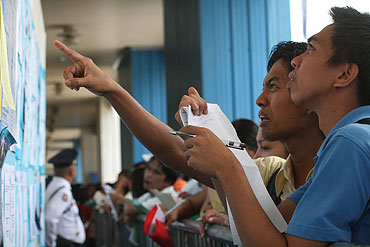By Marilou Aguirre-Tuburan
Davao Today
DAVAO CITY — Unlike most of the overseas Filipino workers who lost their jobs in Taiwan, Isabelita Atis, 29, felt relieved when her plane finally touched down at the Davao International Airport in December last year. She was among the 6,468 thousand overseas Filipinos laid-off in Taiwan after 95 Taiwanese companies were forced to trim down their workers as an effect of the global financial crisis.
Atis said she was glad she got rid of her exhausting job, which was supposed to end in January this year. Unlike other OFWs from Taiwan, she had no debts to pay and had also put up a decent amount of savings.
Other retrenched workers were not as lucky. Those who were laid off with Atis were worried how to pay their debts and how to find another job to support their families.
The Manila Economic and Culturual Office (Meco) in Taiwan reported 13,408 more OFWs who lost their jobs in different parts of the world from October 2008 to February 2009.
Some of those who lost their jobs only stayed in Taiwan for less than a year and had mounting debts to pay.
They had taken the risk of working abroad because of lack of opportunities in the Philippines but even before they could recover the money their families used to send them away, they were back in the Philippines with uncertain job prospects.

JOBS FOR GRABS. Hundreds of job seekers queue at the job fair dubbed Jobapalooza on May 1 in one of the leading malls in Davao. The Department of Labor and Employment initiated the job fair to “address the effects of the global crisis on the workers and the economy.” (davaotoday.com photo by Barry Ohaylan)
Despite her marketing degree, Atis worked as a factory worker in Taiwan. For two years, she worked for an electronics company Lite-on Technology, where she assembled mobile phones, tested and calibrated printed circuit boards.
Workers like her earned a monthly pay of 15,840 Taiwan dollars (20,275 pesos at the exchange rate prevailing during the period).
But in 2005, Lite-On Technology moved to China, leaving Atis and several workers out of job.
Semiconductor foundry Episil Technologies Inc., a producer of silicon wafers, hired Atis as a machine operator in January 2006. Part of her work was the processing and designing of wafers that could be used for appliances, airplanes, and cars among others.
But Atis said workers at Episil were pushed to the limits. Each worker had to operate 13 machines for 10 hours every working day. They were not allowed to sit down. While working, they had to stand for 10 hours and were allowed to rest only during meal breaks. They were also exposed to radiation and chemicals like boron and sulfuric acid used for cleaning the wafers.
Workers received a monthly pay of 17,240 Taiwan dollars (29,308 pesos at the prevailing exchange during the period). For overtime, they were paid 72 Taiwan dollars (Php 122.40) per hour.
They were granted a day’s off after every three consecutive working days each week but when the company had a lot of orders, workers supposed on a day off were still called to work.
When the global financial crisis hit Taiwan in October 2008, Episil announced that their overtime was cut-off. A month later, the company told workers their contracts would no longer be extended.
In November 2008, foreign workers at Episil were sent home. POEA reported 400 OFWs from the export and manufacturing companies in Taiwan retrenched in the second week of November.
The Department of Labor and Employment (Dole) reported 35,000 OFWs working in Taiwan, 30,000 of them in the manufacturing sector.
Taiwanese companies continued to retrench workers the following months. Foreign workers whose contracts had not expired were also advised for an �early-exit� to allow Taiwanese workers to work. Some of those sent home early this year had contracts that were supposed to expire in June.
Atis said Episil made them sign papers that said they had “voluntarily” resigned from the company even if they were only forced to do so.
Those who worked at Episil for less than a year received a 50-thousand peso (34,770.3 Taiwan dollars) separation pay. Atis said it was not even enough to pay for the placement fee they incurred from lending companies, which charged an interest rate of as high as 70 percent.
Atis said she didn�t think the 50-thousand peso separation pay was fair. Those who worked for more than a year, like her, did not receive any separation pay at all. They only got a free airfare back to the Philippines.
Migrante International, a global group assisting Filipino migrant workers, said some of the retrenched OFWs in Taiwan were intimidated into signing agreements that were disadvantageous to them. Migrante cited the case of 162 retrenched OFWs from Walton Advanced Engineering Inc. (WAIE).
A Taiwanese broker reportedly told the WAEI workers they would not get any separation pay nor provisions for food and airfare to the Philippines if they refused to sign the agreement.
He also reminded the workers that they�d have to pay 20 percent income tax if they stayed for less than 183 days in Taiwan, a policy of Taiwan�s Ministry of Finance. Most of the retrenched workers were employed only for four to six months in Taiwan, hence, were scared to incur additional expenses.
Migrante said the rate of retrenchments in Taiwan has become so alarming that the number of retrenched workers may go over the 11,000 earlier projected by Taiwan’s Council of Labor Affairs this year.
In April this year, a hundred of the 213 displaced Taiwan OFWs sought the help of the Overseas Workers Welfare Administration (OWWA) in Southern Mindanao.
Ron Lionel Bartolome, OWWA regional director, said his office approved the application of 64 displaced OFWs for the Filipino Expatriates Livelihood Support Fund Loan, amounting to 50,000 pesos each.
He said the zero-interest loan was payable in two years with three months grace period. OWWA�s other assistance to displaced OFWs included basic computer training to OFW dependents and vocational courses under the Skills for Employment Scholarship Program.
Bartolome said displaced OFWs only had three options open where OWWA can help them: seek for local employment, seek for another overseas job or put up their own businesses.
The OWWA office did not have any data on the exact number of displaced OFWs from the region but as of April last year, it monitored 46,583 sea-based and land-based OFWs working abroad.
The Philippine Overseas Employment Administration (POEA) reported some 1.377 million OFWs deployed around 190 countries in 2008 alone.
As early as November last year, DoLE formed a quick reaction team (QRT) to help displaced OFWs from Taiwan and other countries affected by the crisis.
Secretary Marianito Roque said the QRT targeted to find some placement for the displaced OFWs in other countries.
DoLE also set up Philippine Overseas Labor Offices (POLOs) in more than 30 strategic host destinations around the world to monitor and secure the benefits of displaced workers, provide job replacement and repatriation assistance.
Of the 5,404 OFWs displaced in January this year, 613 were provided with emergency employment assistance, 965 with job referrals, 1,007 with legal assistance on their money claims, 422 with skills training and, 1,453 with livelihood assistance.
The National Reintegration Center for OFWs also put up a one-stop center, providing free counseling services to workers.
Roque said OWWA also encouraged more OFWs to become entrepreneurs, hence, were providing entrepreneurship training for displaced OFWs.
President Arroyo signed in December last year the administrative order allocating 250-million peso for the OWWA to assist displaced workers.
But Migrante International said most OFWs could not afford the government�s livelihood programs. �Government�s so-called �assistance package� were loans which OFWs had to repay,� Gina Gaborni, Migrante International deputy secretary general, pointed out. �They could hardly afford it,� she said.
�Besides, only 10 percent or 5,000 pesos of the allotted 50,000 pesos for each expatriate worker is available,� she said. �The rest (of the assistance) are in goods. Before anyone can avail himself of these benefits, one has to attend seminars, trainings, draw a feasibility study for a livelihood program and other requirements,� Gaborni said.
Gaborni said the government should protect the labor rights of retrenched workers instead of giving them false hopes on other jobs abroad. (Marilou Aguirre-Tuburan/davaotoday.com)
OFWS & Migration









